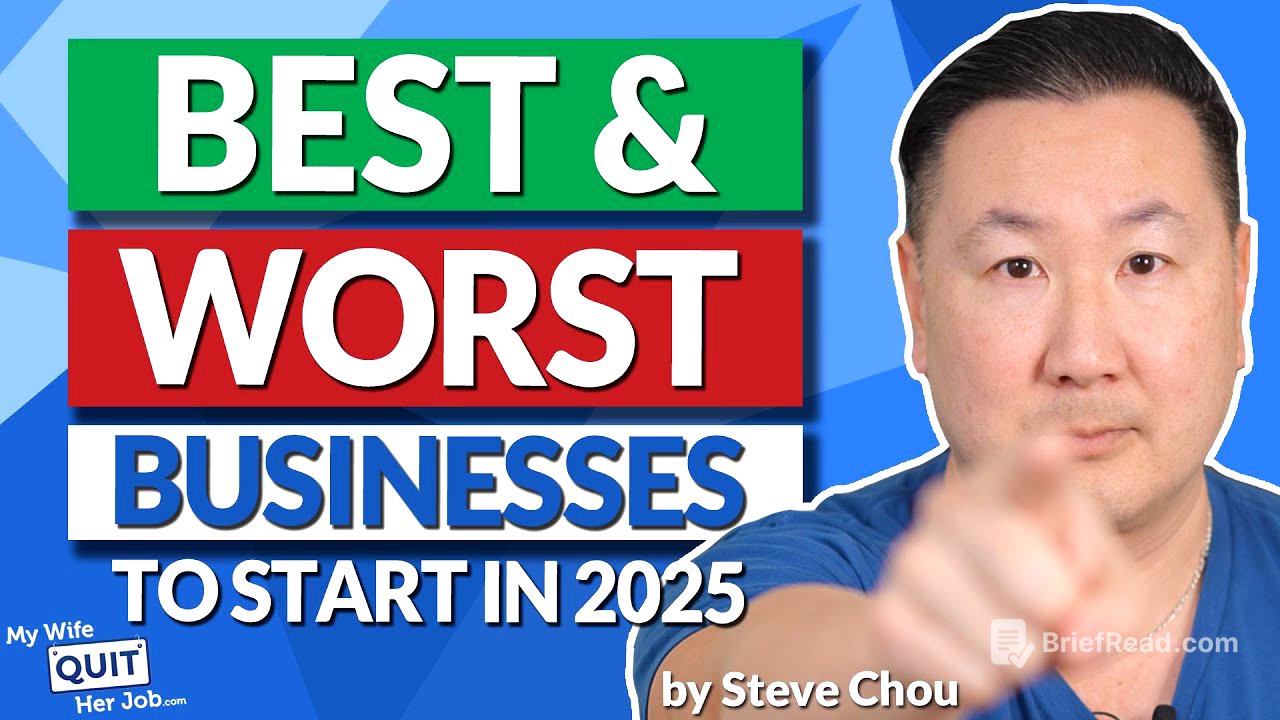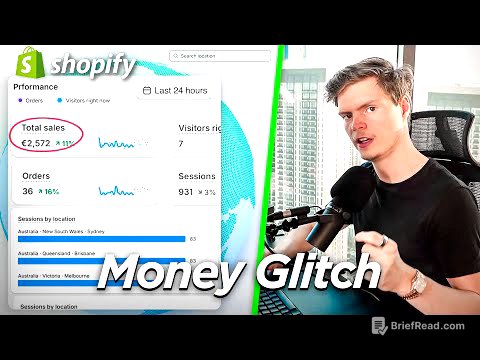TLDR;
This video discusses various online business models, ranking them based on risk, scalability, and sustainability. It advises against popular but often unsuccessful models like dropshipping from AliExpress, and highlights more promising options such as private labelling and selling digital products. The key takeaway is to focus on businesses with higher barriers to entry, strong profit potential, and infinite scalability for long-term wealth creation.
- Avoid low-barrier, high-competition models like AliExpress dropshipping.
- Consider private labelling for higher control over branding and profit margins.
- Digital products offer the highest scalability and profit margins, but require building an audience and reputation.
- Focus on creating a product once and selling it repeatedly for long-term wealth.
Intro [0:00]
The video aims to provide a realistic view of starting a business in 2025, moving away from the overhyped "passive income" models like dropshipping and affiliate marketing that often lead to failure for beginners. The presenter shares personal experience and market research to highlight proven, low-risk, scalable, and sustainable business opportunities. The video emphasises smart business strategies over the illusion of easy money, guiding viewers towards paths that increase their chances of success and avoid common pitfalls.
The First Type Of Business I Want To Address [1:28]
The first business model discussed is product-based dropshipping, where products are sold online without holding inventory. When an order is placed, the product is bought from a supplier who ships it directly to the customer. While dropshipping offers a low-cost entry point, it typically suffers from thin profit margins, intense competition, and reliance on suppliers for shipping and quality. AliExpress dropshipping is particularly criticised due to non-existent quality control and lengthy shipping times, often leading to dissatisfied customers. Although high-ticket dropshipping and print-on-demand can be viable, the model is best used as a stepping stone to test products before transitioning to a branded, private label version. Overall, dropshipping is considered a D-tier business model.
The Next Type Of Business I Want To Talk About [3:41]
The next business model examined is freelancing, where services like website design, copywriting, or graphic design are provided for a fee. Freelancing offers the advantage of immediate payment for time and requires minimal initial infrastructure, making it a good way to gain experience. However, it involves trading time for money, similar to a 9-to-5 job, but with the added burden of constantly seeking new clients and lacking benefits like insurance or a retirement plan. Freelancing is not easily scalable, and managing employees in an agency setting can be challenging. As a result, freelancing is placed in the C tier as a decent short-term income source but not ideal for long-term financial freedom.
The Next Business Model [5:20]
Becoming a professional content creator, which includes earning money through videos, blogs, podcasts, or social media, is the next business model. This YouTube channel, for example, generates six figures annually from ads, sponsorships, and affiliate marketing. Content creation offers multiple income streams, including membership sites, private communities, and digital products, with complete control over monetisation. While a smartphone is sufficient to start, the market is highly competitive, with many aspiring influencers. Despite the challenges of creating engaging content and dealing with potential discouragement from low viewership, content creation is considered a scalable business model, earning it a B tier rating.
The Next Business Model [7:24]
The next business model discussed is selling private label products, where existing products are improved and branded as your own. This involves working with a manufacturer to customise the product's functionality, packaging, and logo, allowing for brand building without high upfront costs. Private labelling offers more control over pricing and branding compared to dropshipping. For example, the presenter's store sells personalised mother-daughter aprons with high profit margins. Private label businesses can be highly profitable and scalable, with the potential for long-term success. Although it requires more initial investment (around $3,000) and learning how to manage overseas suppliers, private labelling is considered an A-tier business model for its sustainability and profitability.
S-Tier Business Model [9:45]
Selling digital products is presented as the S-tier business model. This includes templates, software tools, courses, workshops, and memberships, offering the benefits of private labelling without the inventory management issues. Digital products are knowledge-based and delivered online, making them highly scalable. With margins over 90%, the presenter's website sells courses and memberships. The production costs are minimal, primarily involving time spent creating content. While the market is saturated, success requires building an audience and reputation. Despite the effort required, digital products offer the least hassle and highest profit margins, making it an easily scalable business model and the top-rated option.









